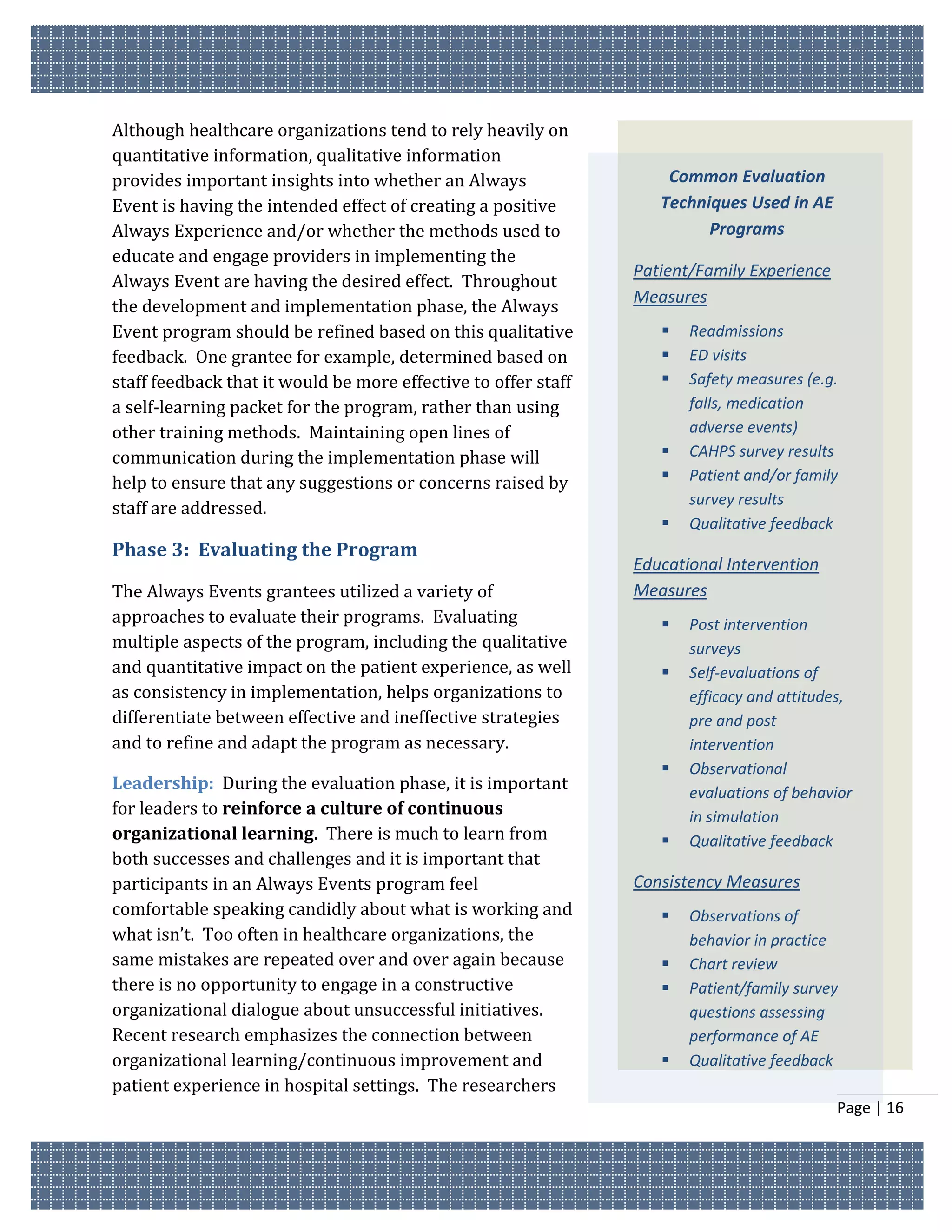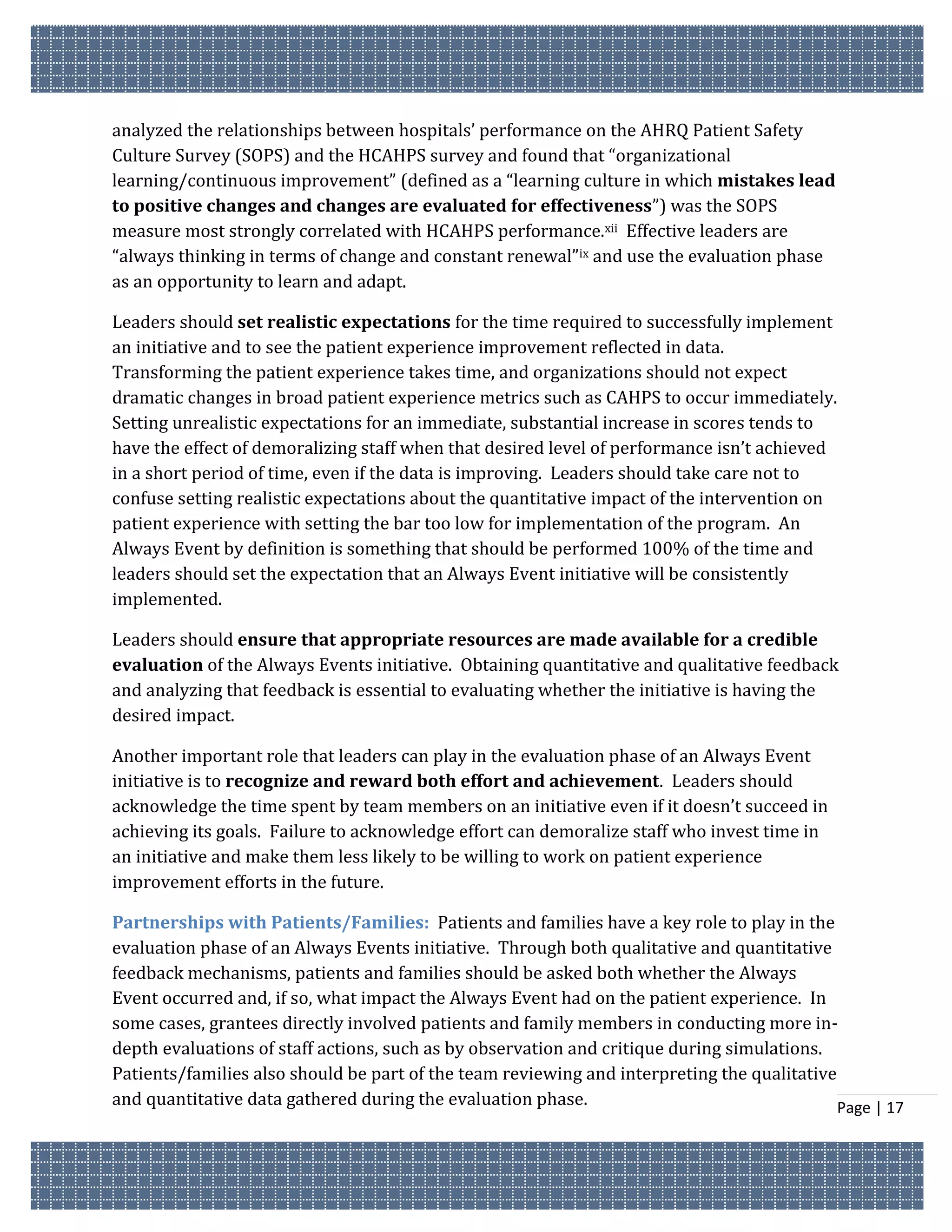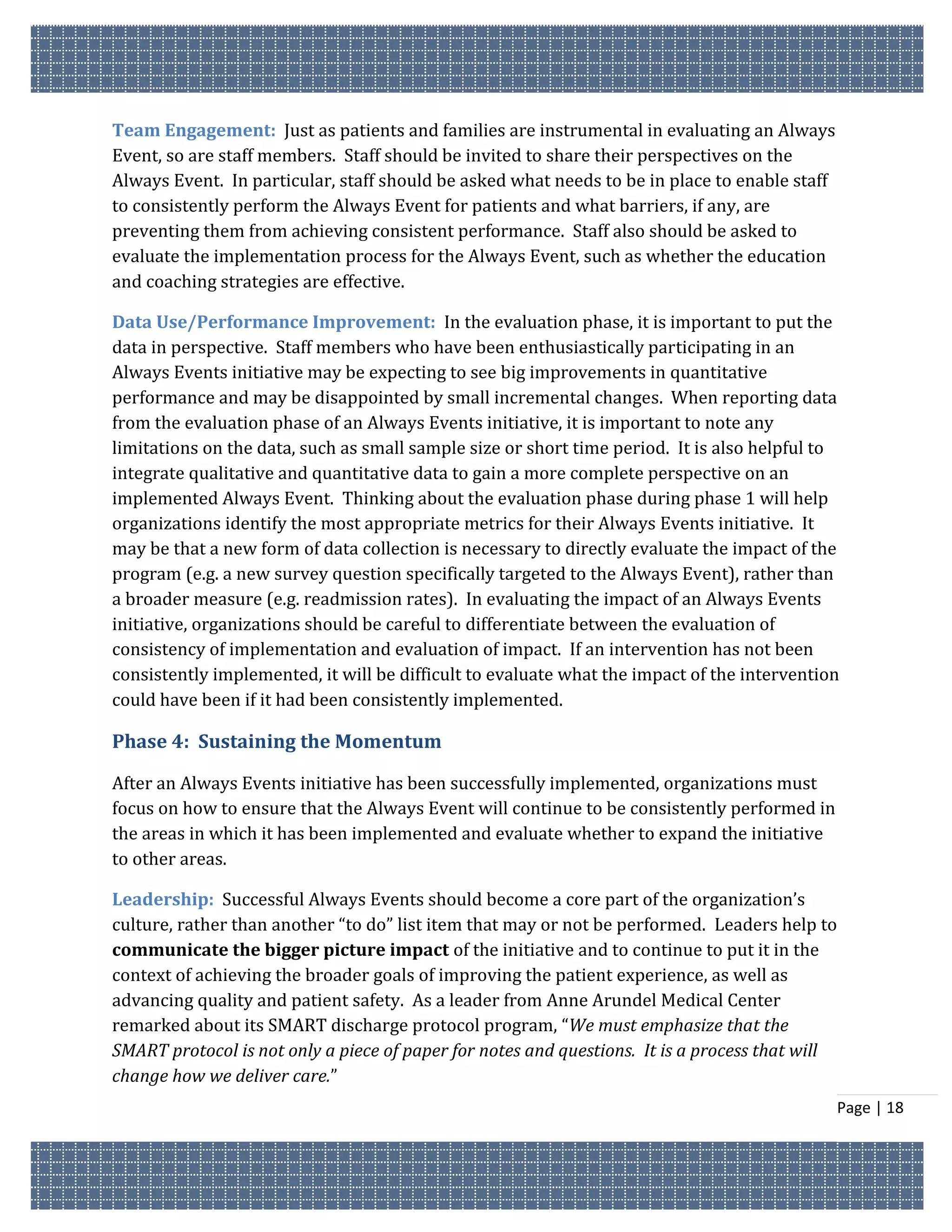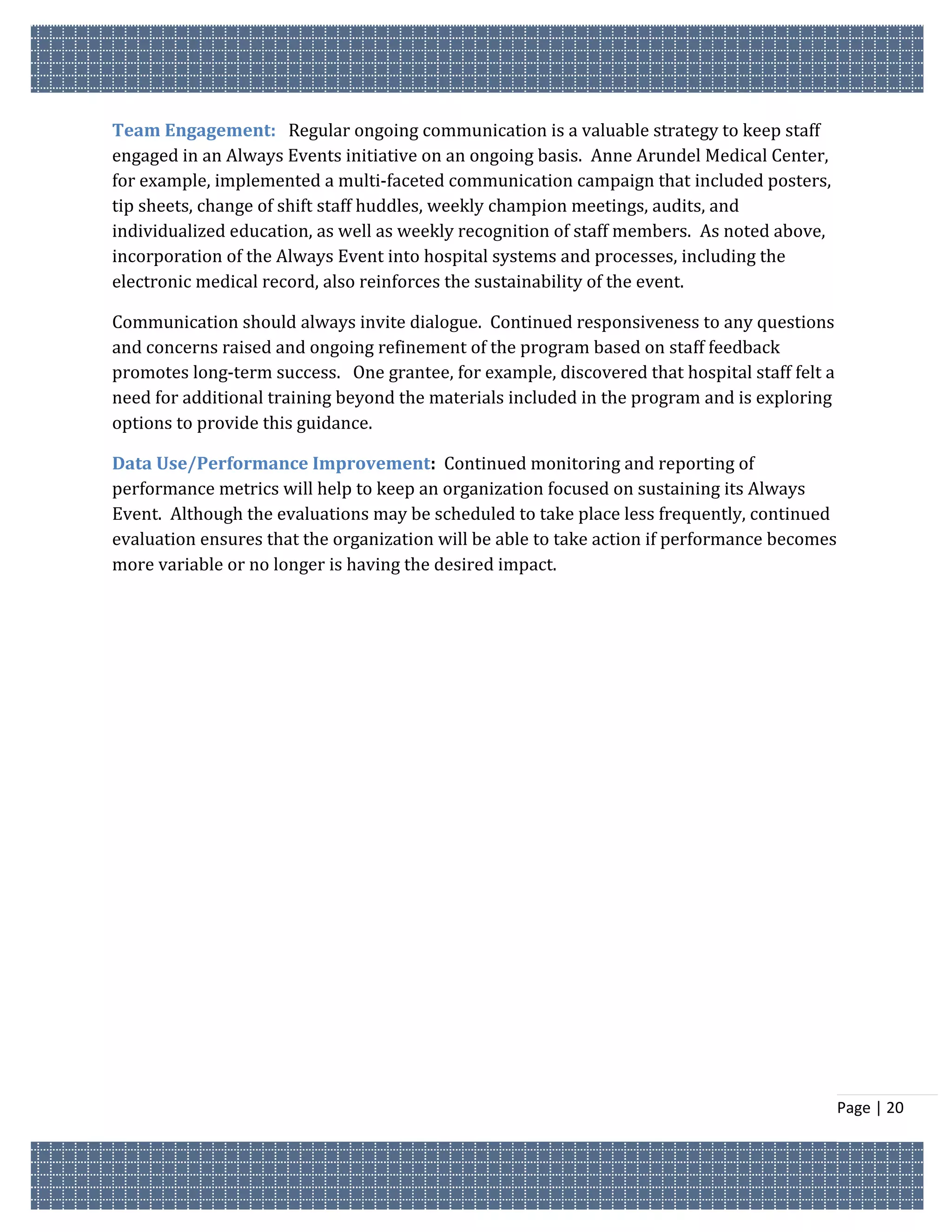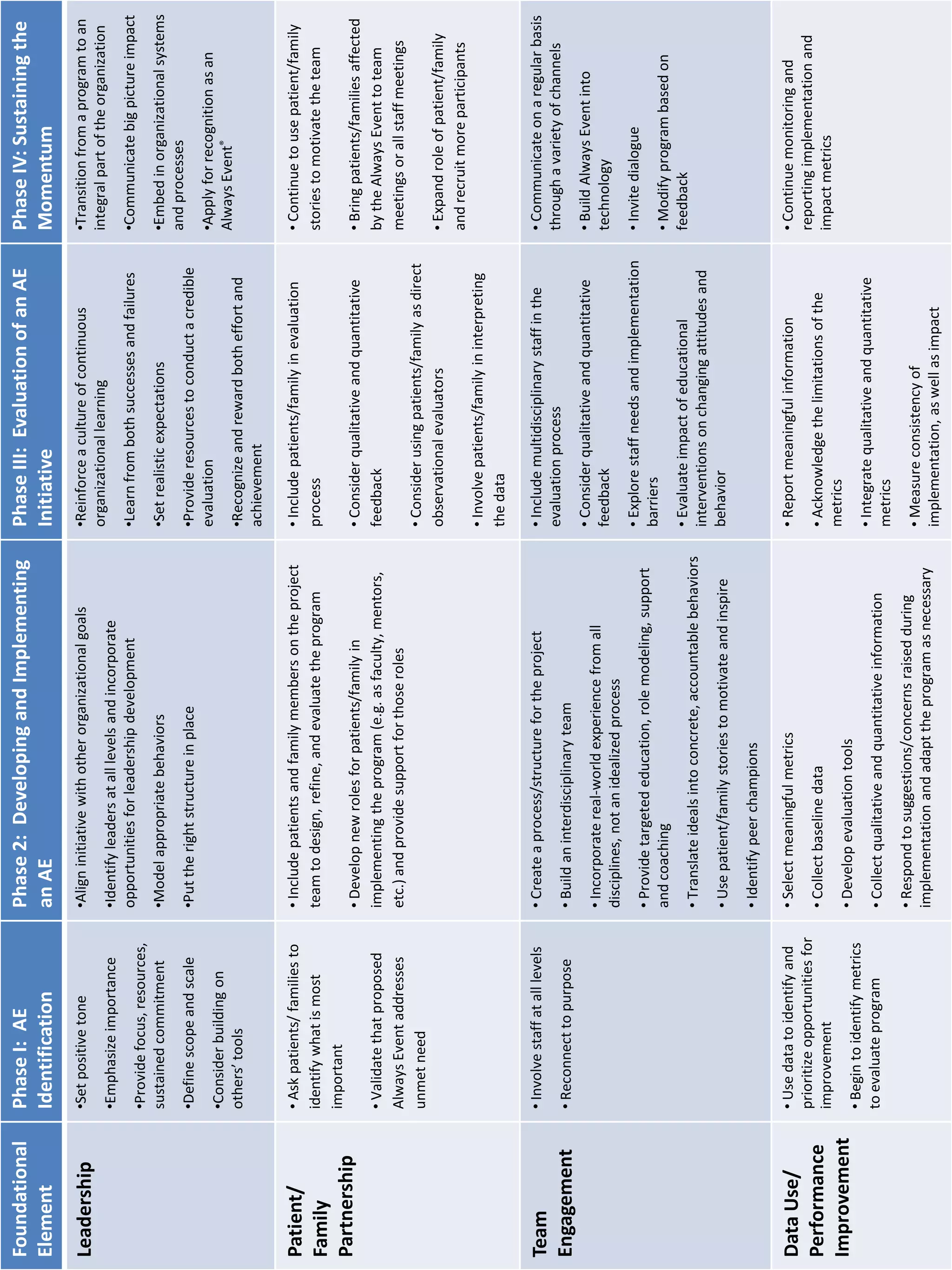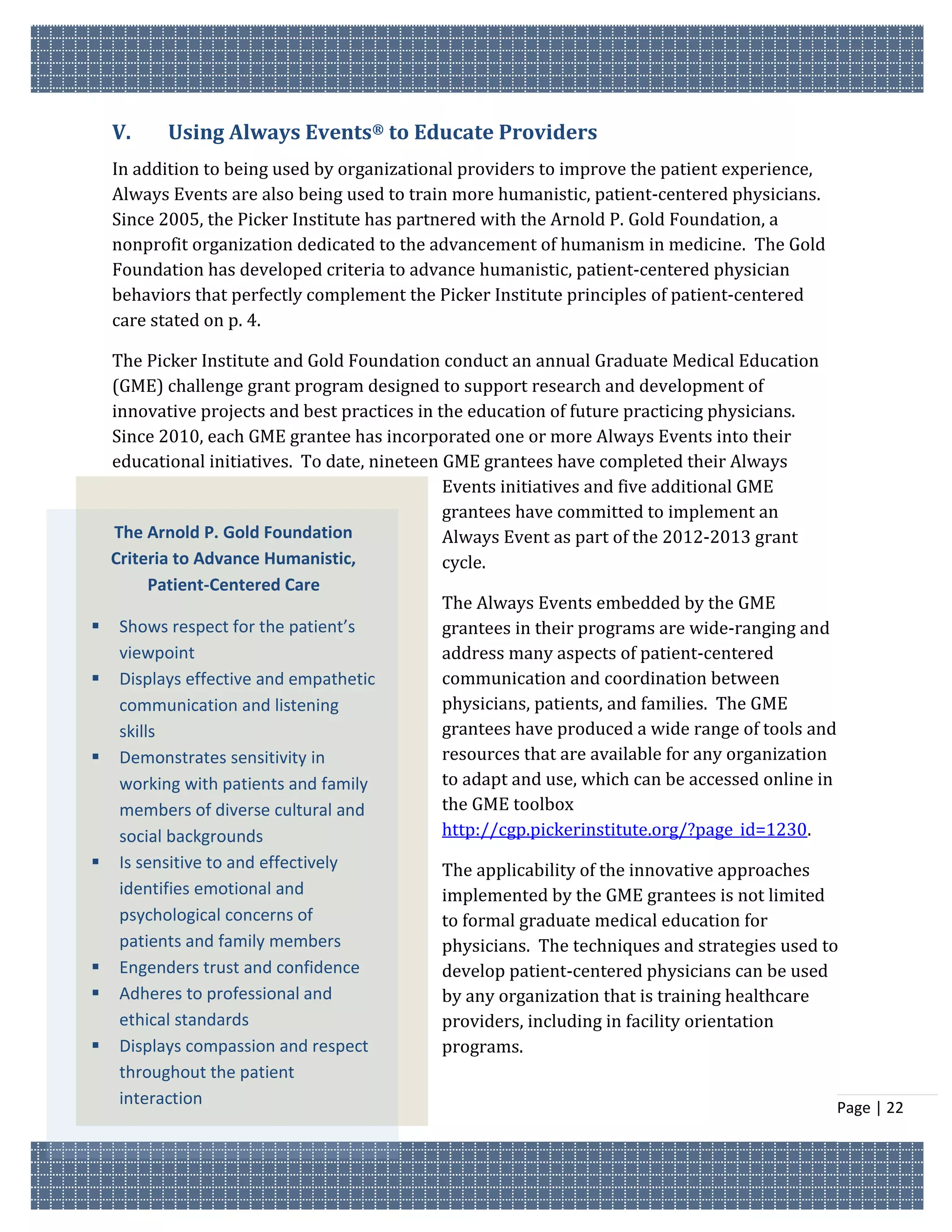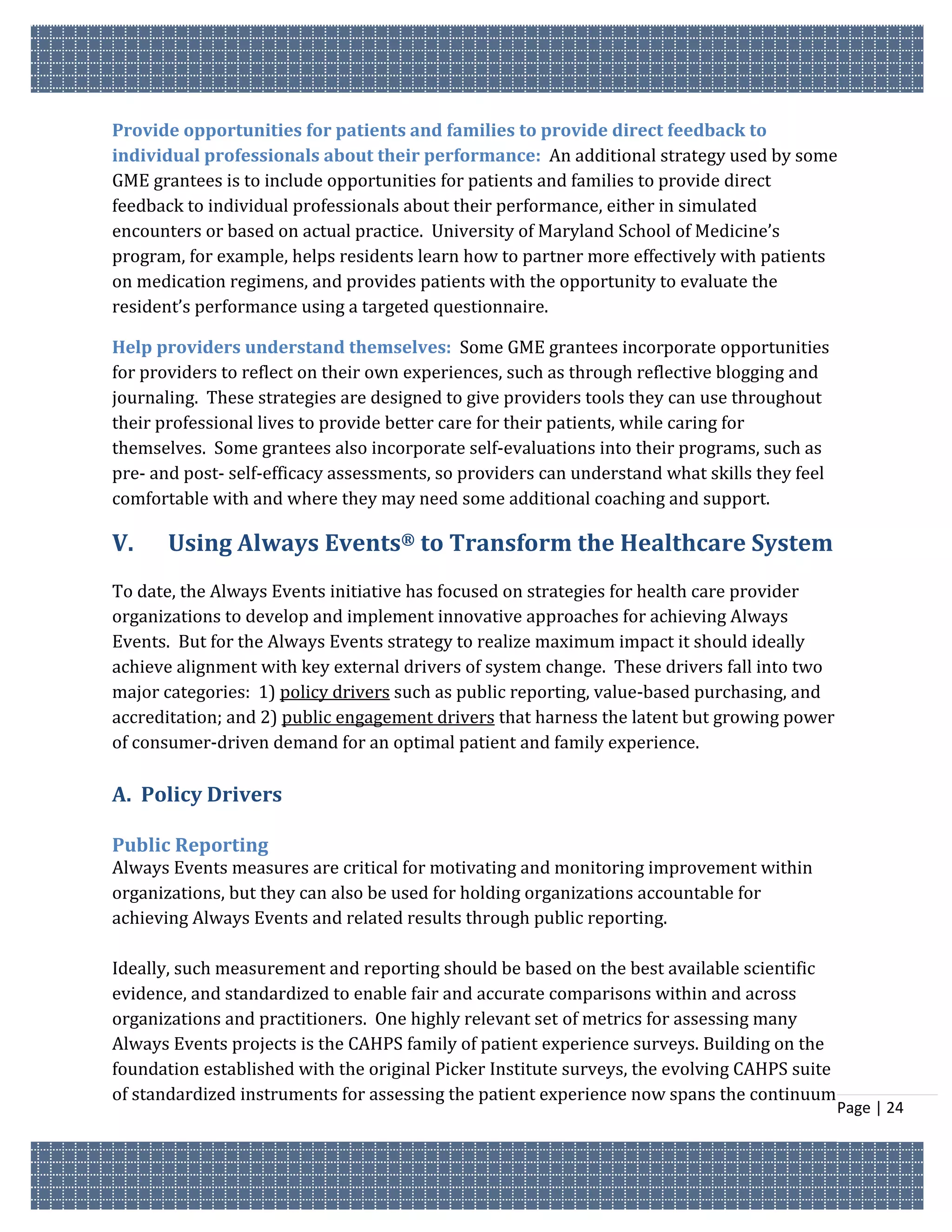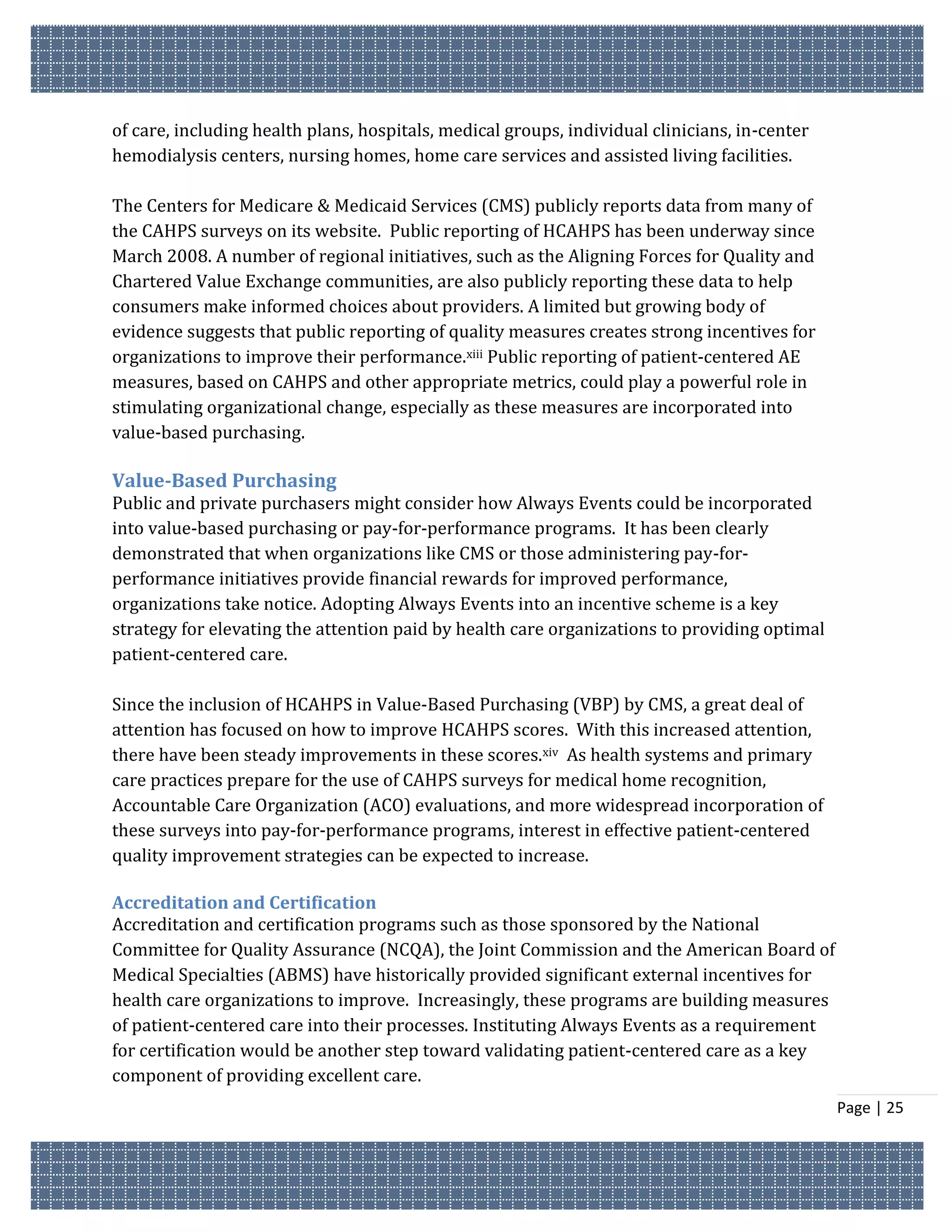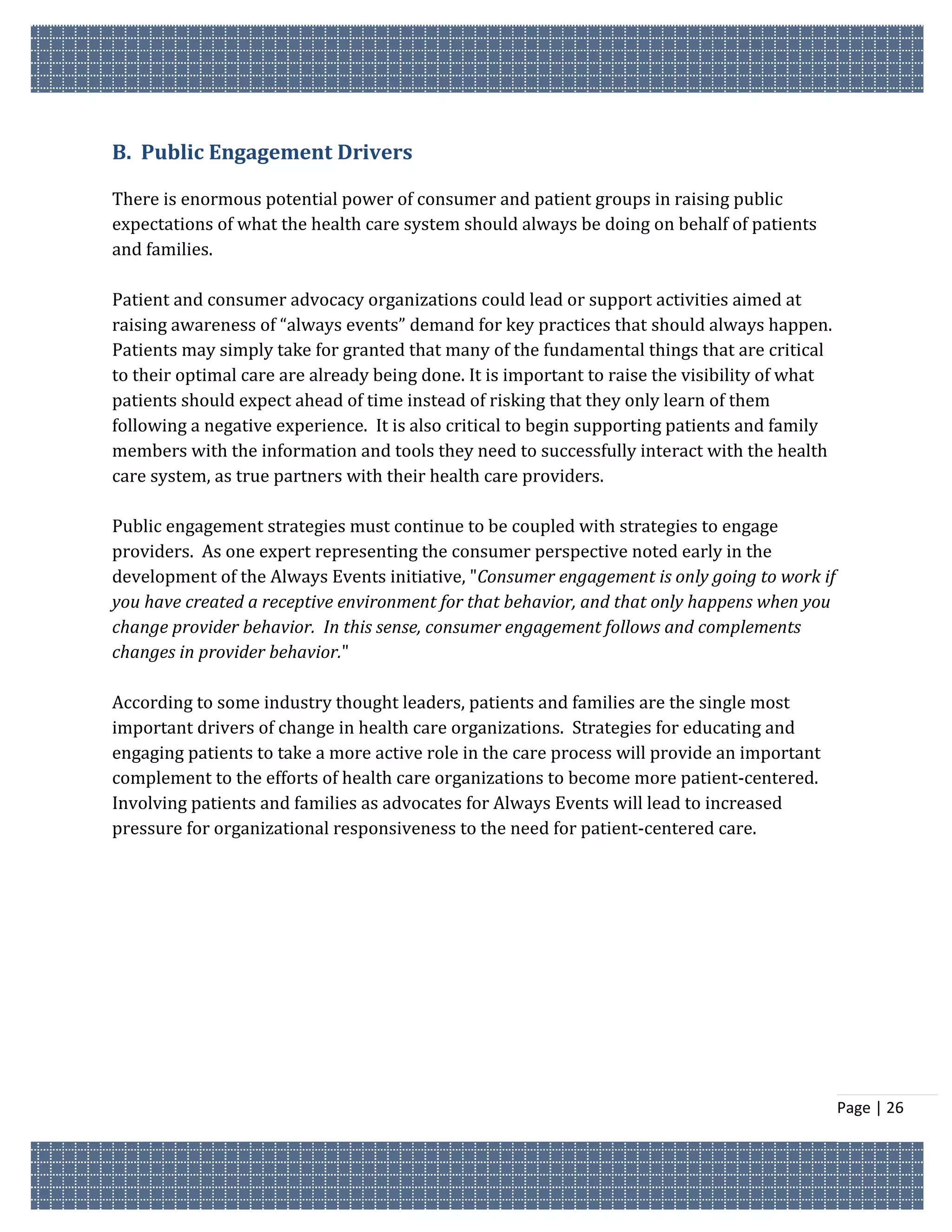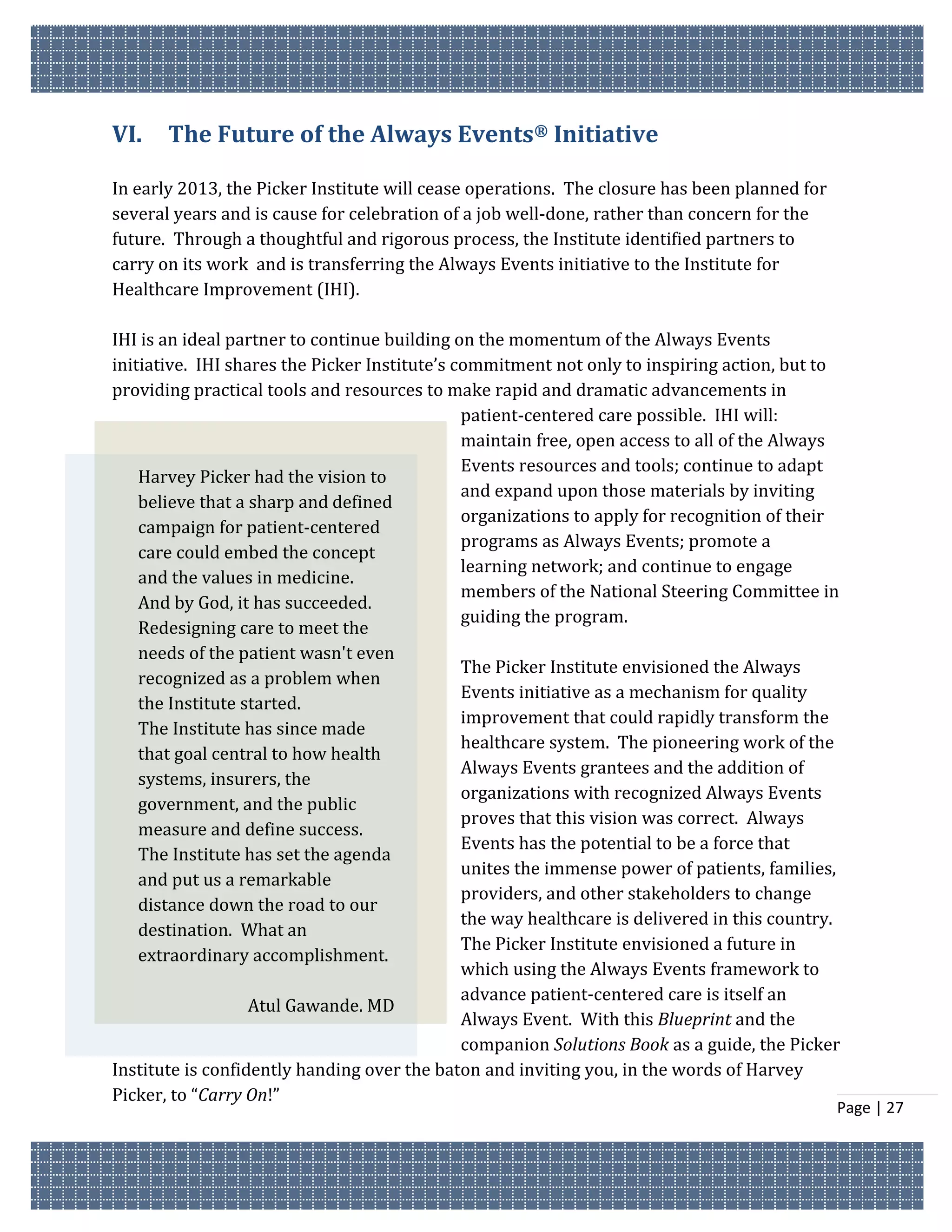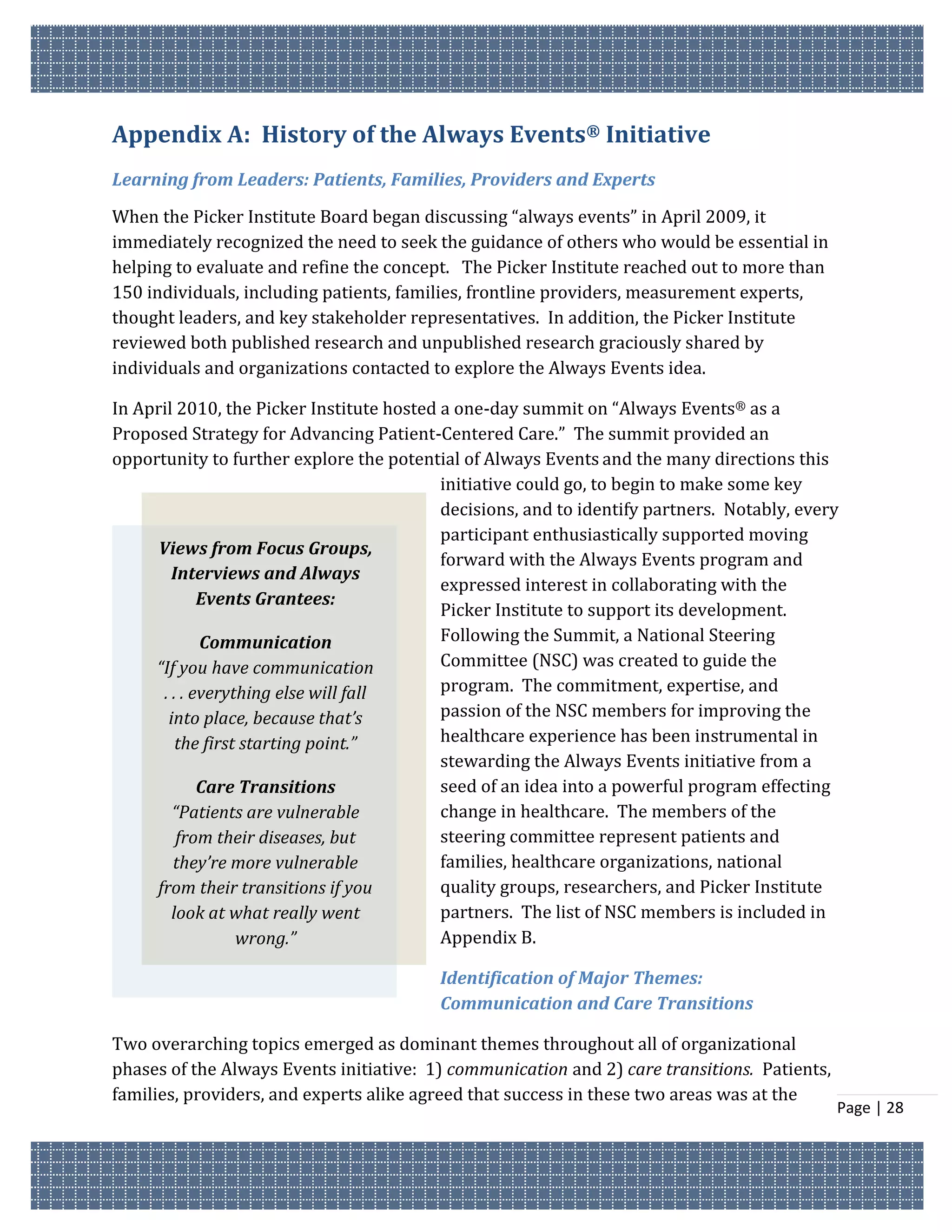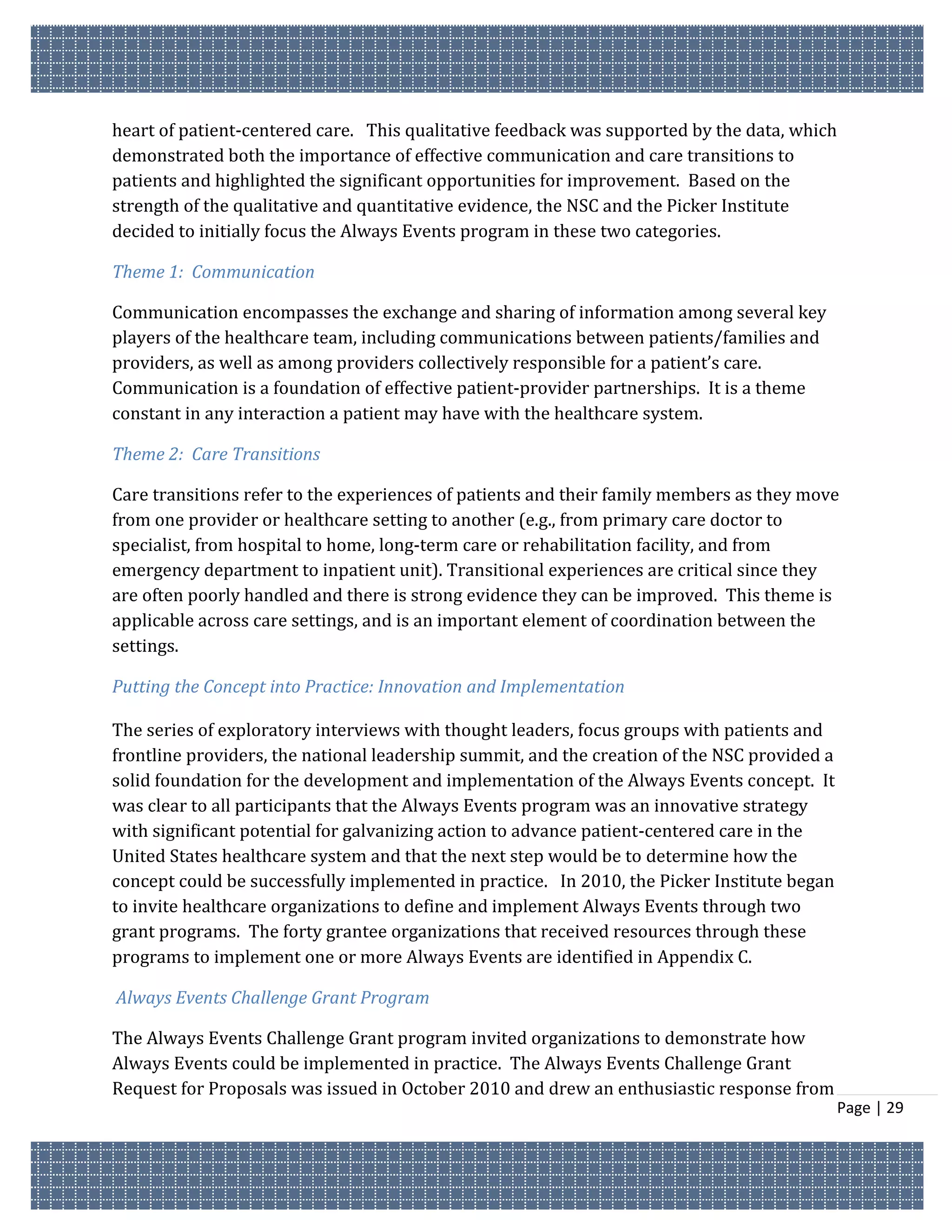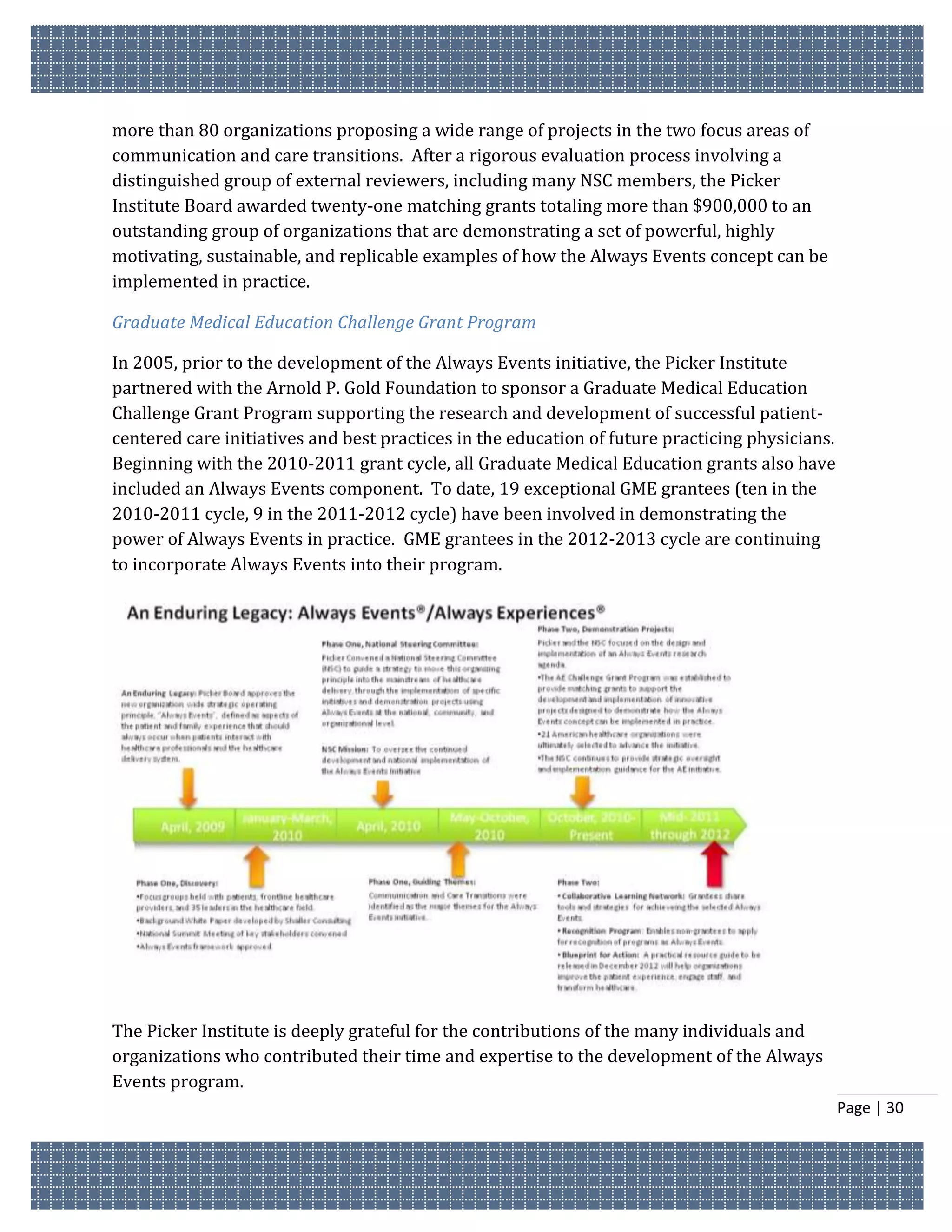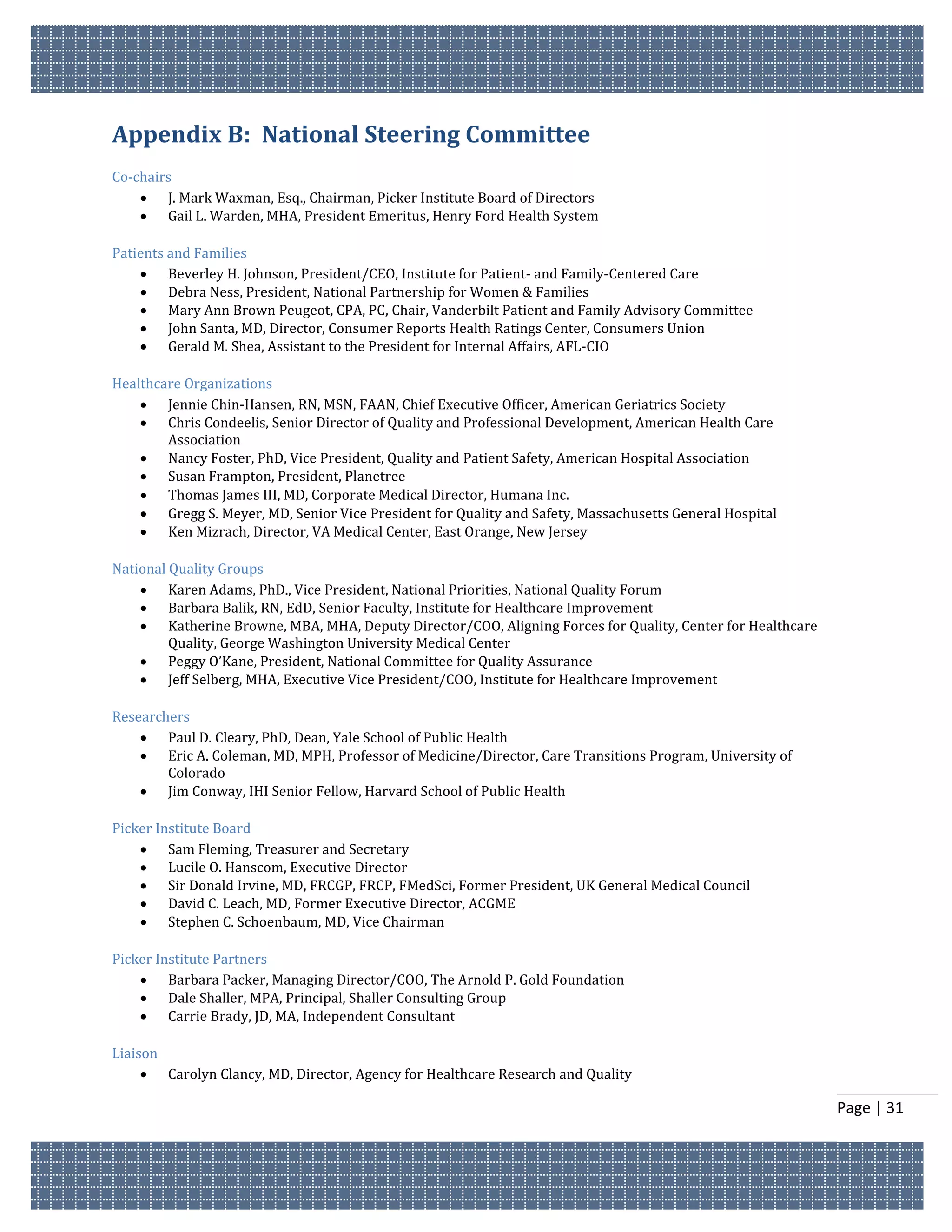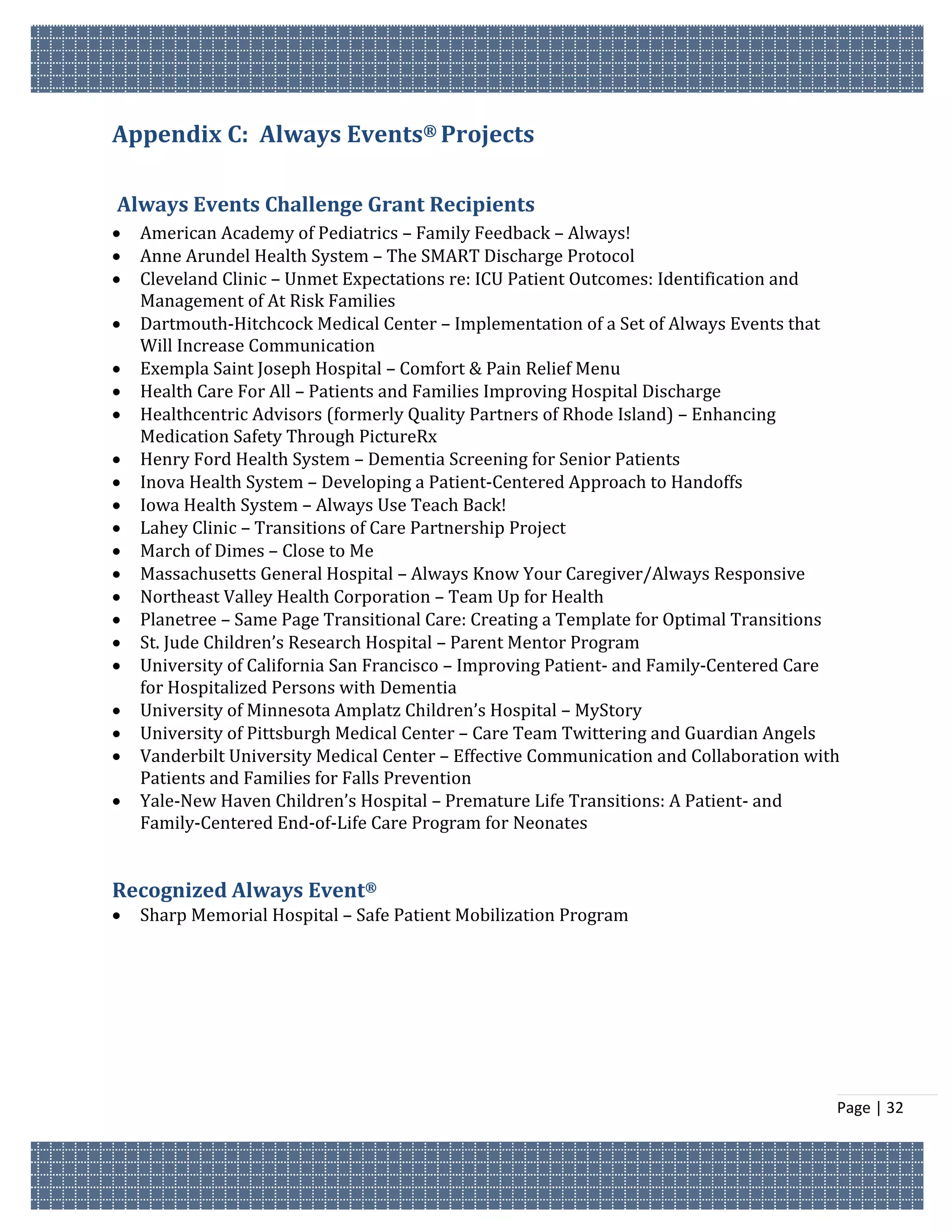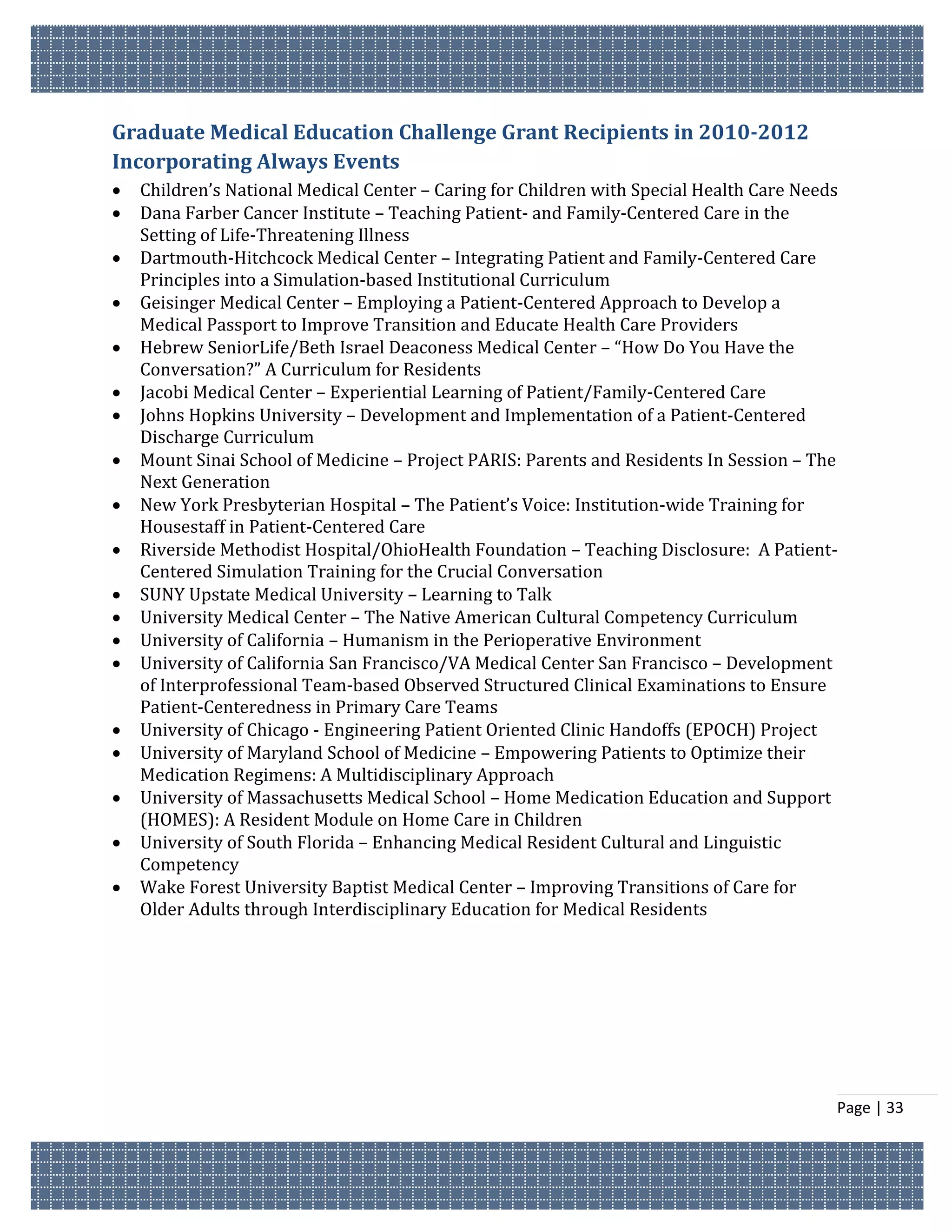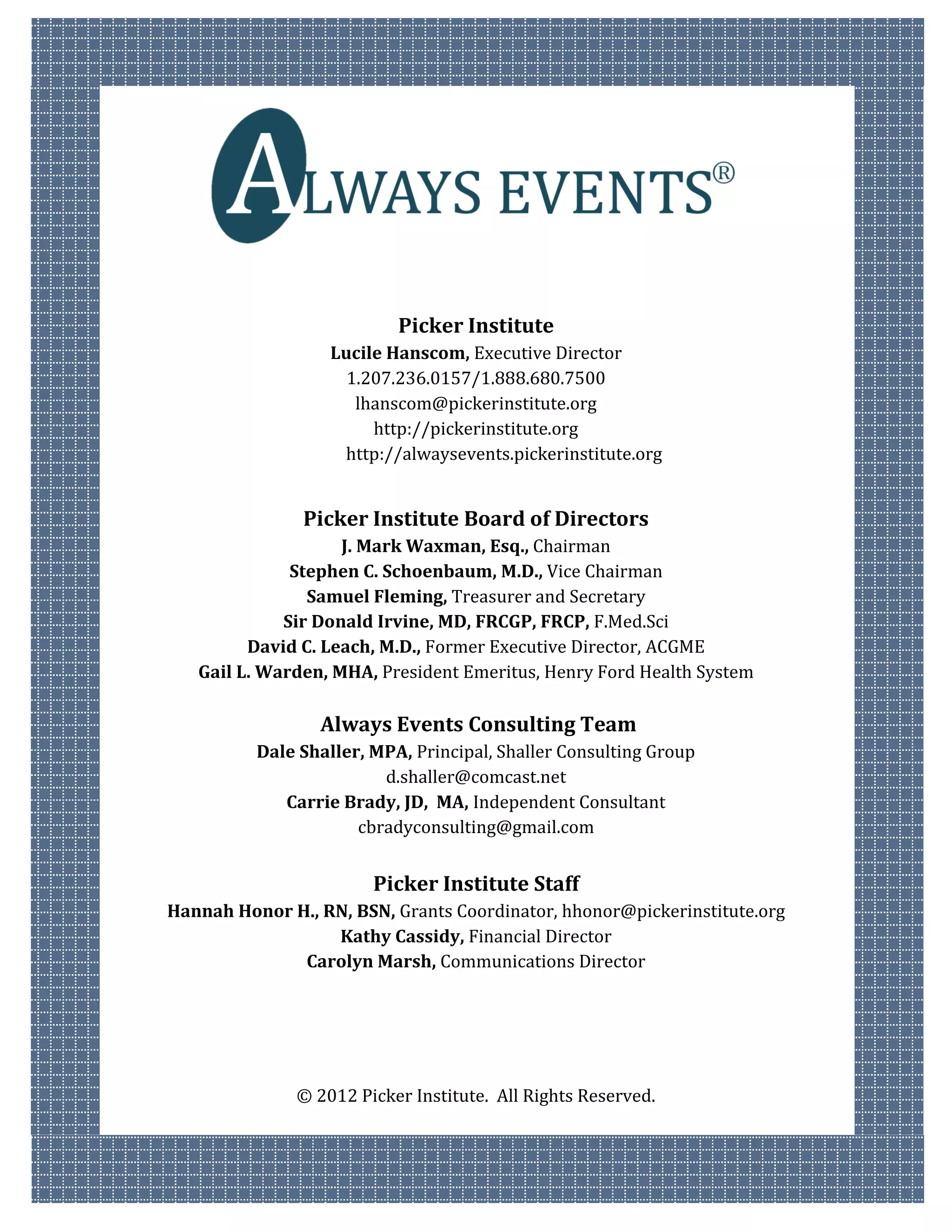This document provides a blueprint for using Always Events to transform healthcare organizations and improve the patient experience. Always Events refer to aspects of care that are so important to patients that providers should always perform them consistently. Over 80 organizations have implemented Always Events projects to address challenges like communication, care transitions, patient and family engagement, and safety. Their results and lessons learned provide a roadmap for other organizations. The blueprint describes how healthcare leaders, educators, and other stakeholders can use Always Events to advance patient-centered care and transform the healthcare system.
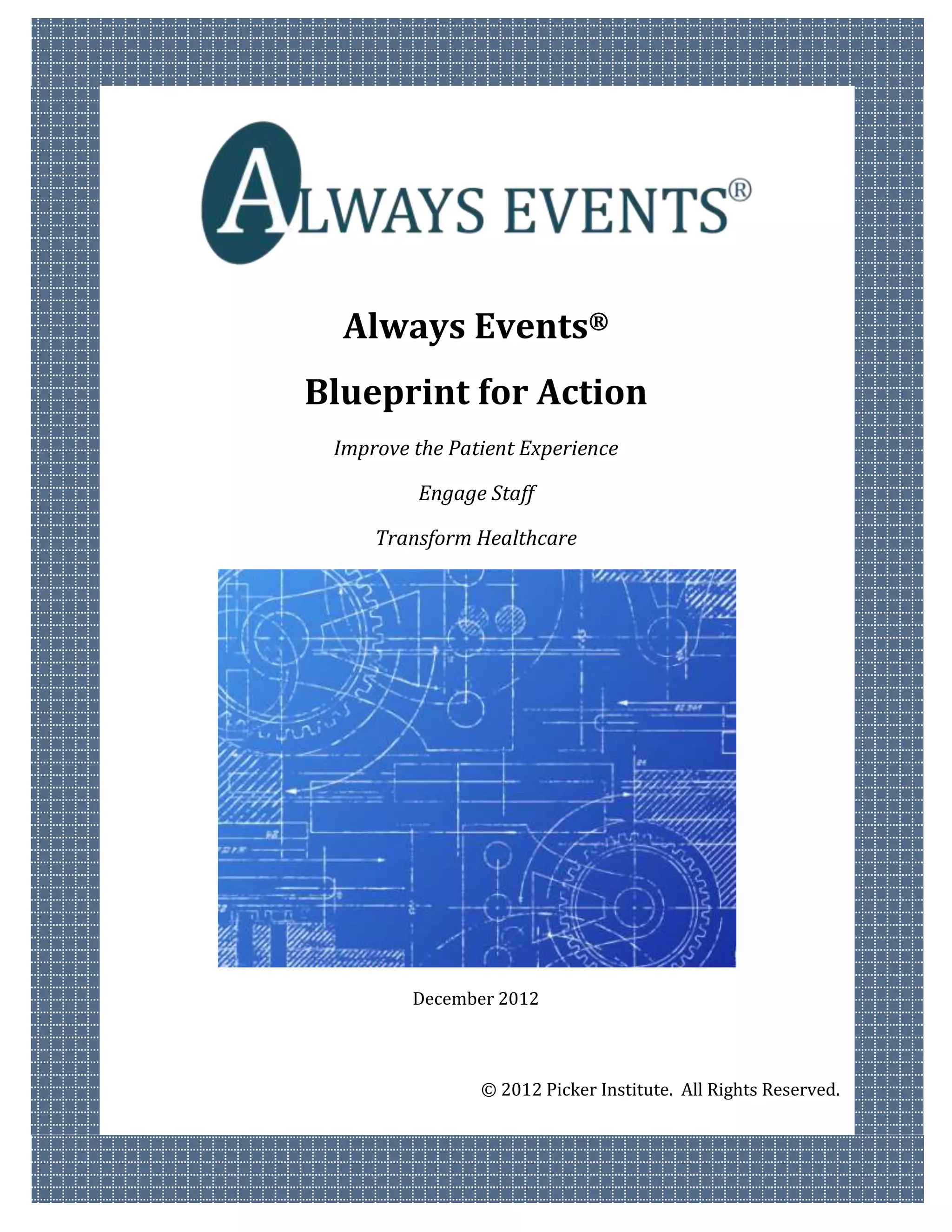

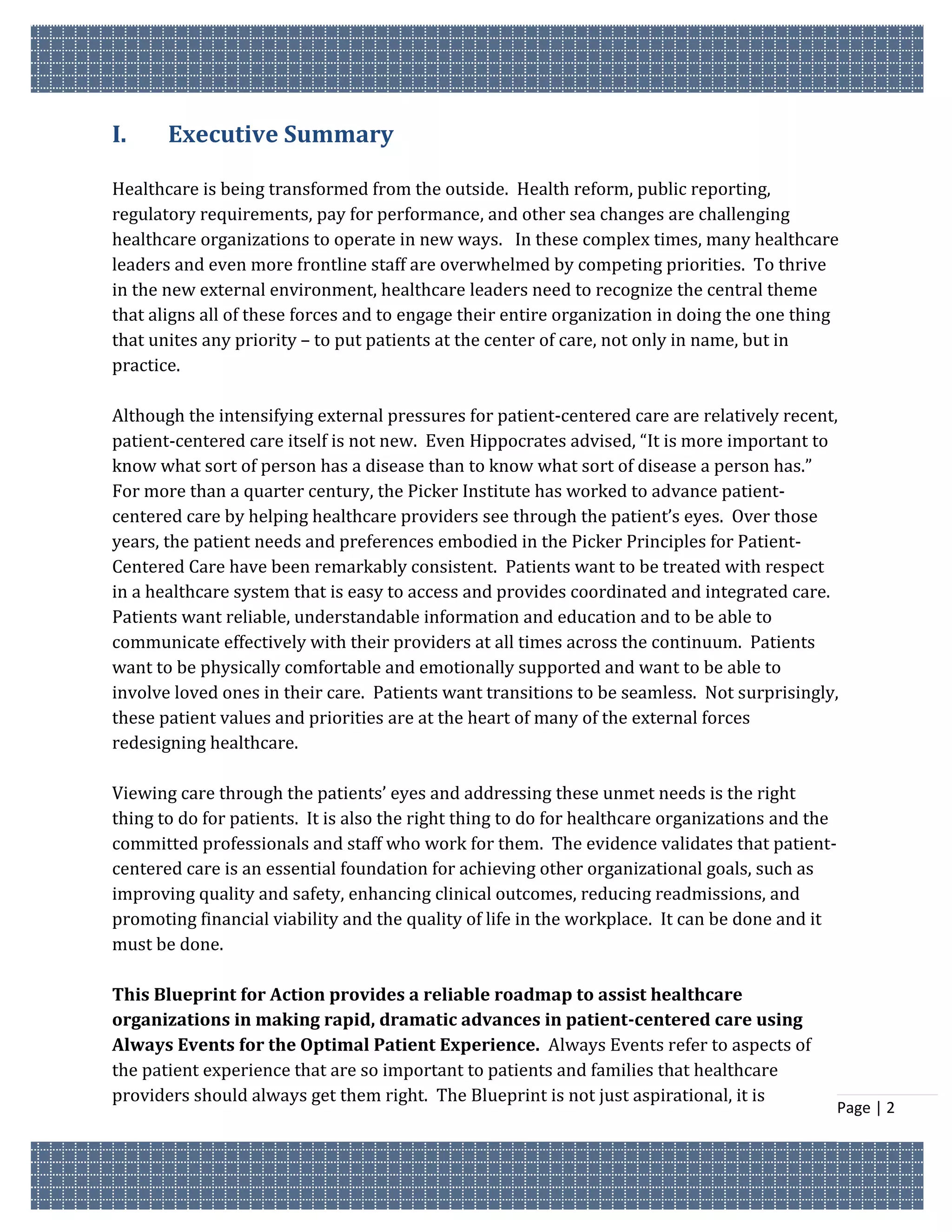
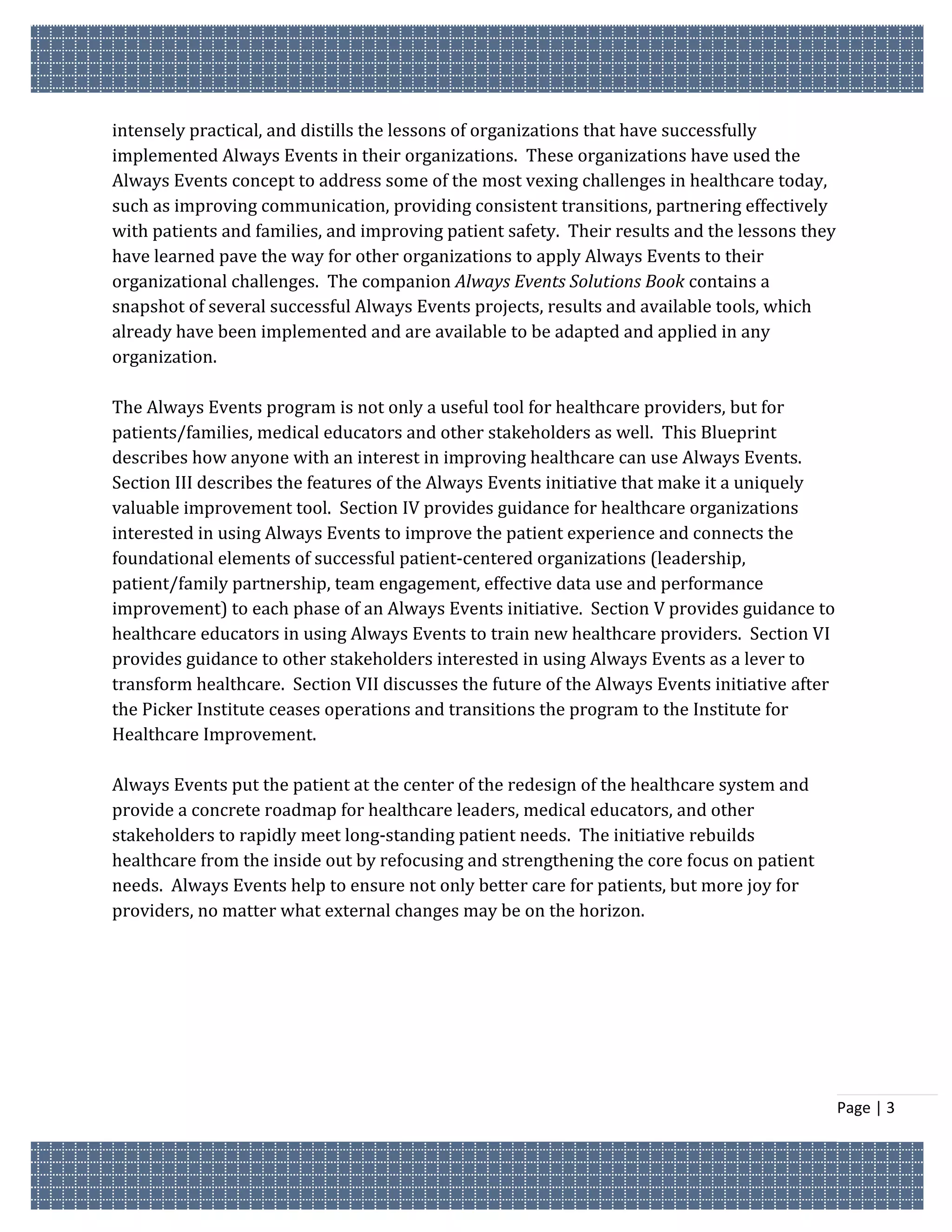
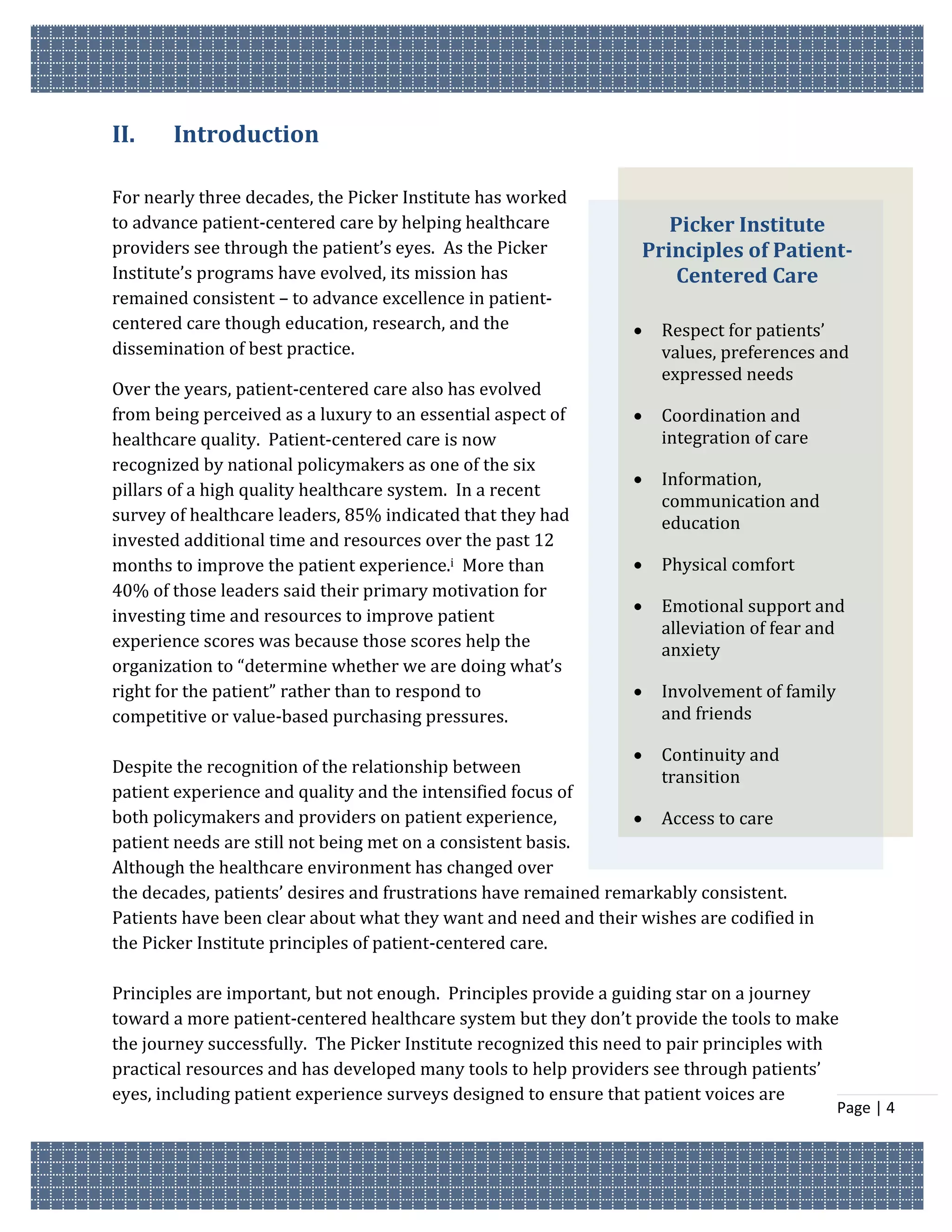

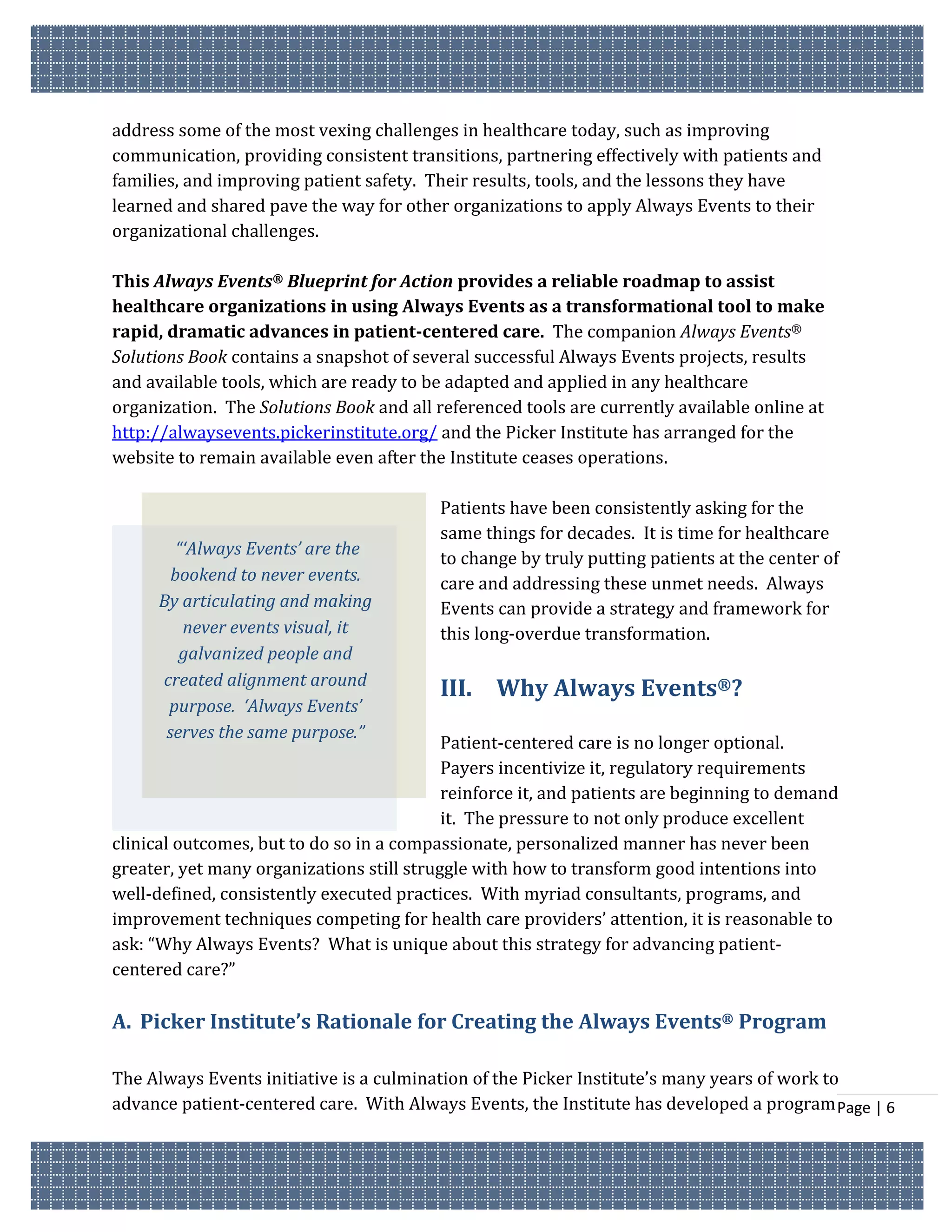
![that remains focused on the guiding principles of patient-centered care and translates
those aspirations into concrete terms that any organization can consistently implement.
The Always Events initiative is readily understood and enthusiastically endorsed by
patients, families, healthcare providers, and other stakeholders. It resonates across
industry and stakeholder lines and can be used in a multitude of ways to improve patient
experience, engage staff, and transform healthcare. It serves as a call to action for a
healthcare system that will consistently deliver patient-centered care to every patient,
every time, and it provides the necessary tools to make rapid action possible.
B. Unique Features of the Always Events® Initiative
There are many unique features of the Always Events initiative, including its positive focus,
open architecture, and community of organizations sharing resources.
Builds Relationships by Focusing on the
“[T]he concept of ‘Always Positive
Events’ for hospitals and Too often, healthcare improvement efforts focus
doctors is the medical exclusively on what is wrong with healthcare,
measurement equivalent of rather than how to build on what is already done
that popular management tool well and do it consistently. Always Events give
of ‘Always catch someone doing organizations the opportunity to reframe their
it right!’ Physicians are likely discussions of patient-centered care in a positive
to want to participate in intention-based manner that builds
discussions about these positive relationships between and among patients,
and important aspects of the families, and staff. The approach is similar to an
care experience.” “appreciative inquiry” process that highlights
what is working well and determines how to
Tom James, MD
learn from and expand upon that success to
Medical Director, National
promote consistent performance of the Always
Network Operations, Humana Inc.
Event with every patient, every time.
Open Architecture Enables Rapid Adaptation and Innovation
One of the many important decisions made during the development of the Always Events
initiative was the decision to maintain an open architecture for the program, rather than
creating a discrete list of Always Events. There were many factors supporting this decision.
Although a short list of clearly defined Always Events could, in theory, improve care, it
would be impossible to establish one prioritized list that would be relevant to all settings Page | 7](https://image.slidesharecdn.com/alwayseventsblueprintforaction11-2012-121212060708-phpapp02/75/Always-Events-Blueprint-for-Action-8-2048.jpg)
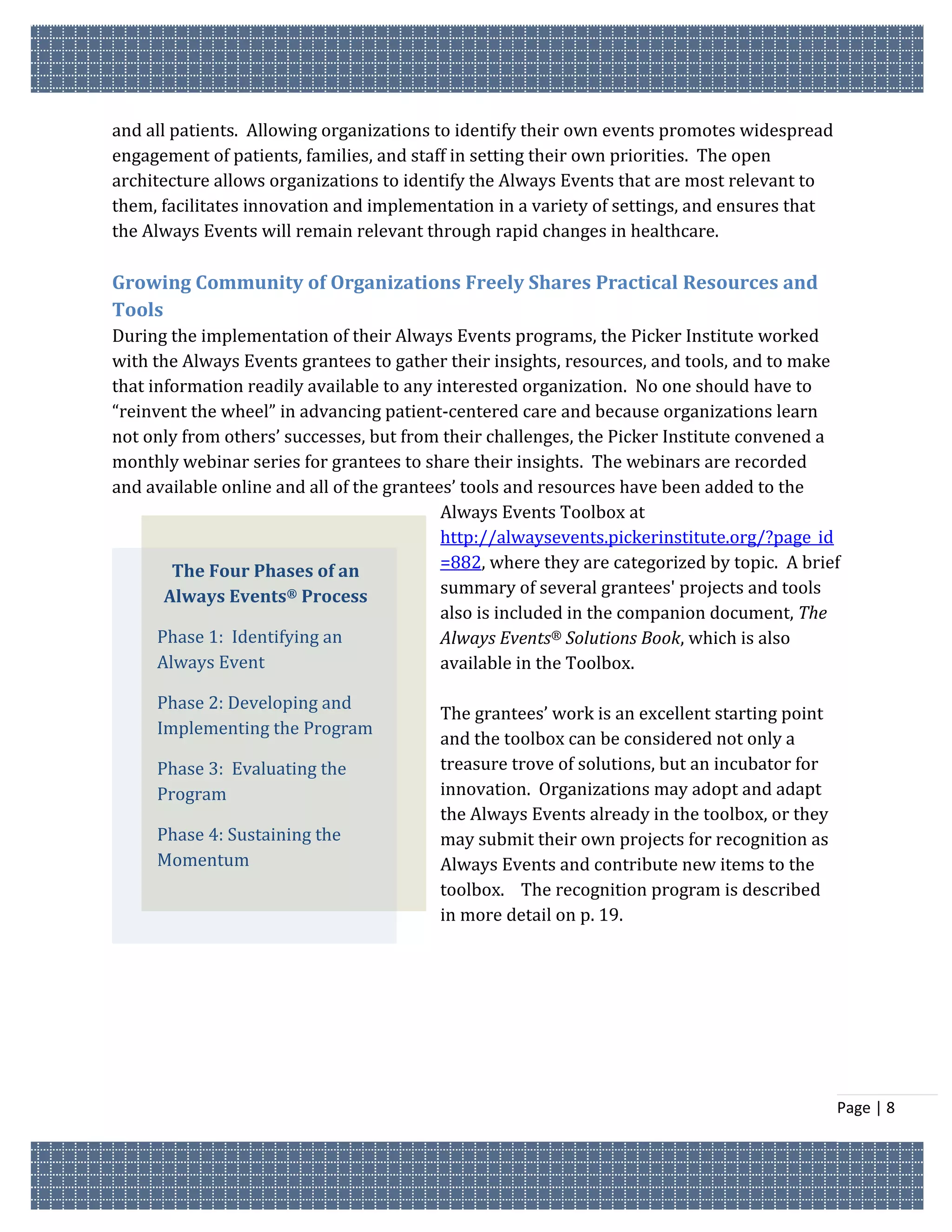
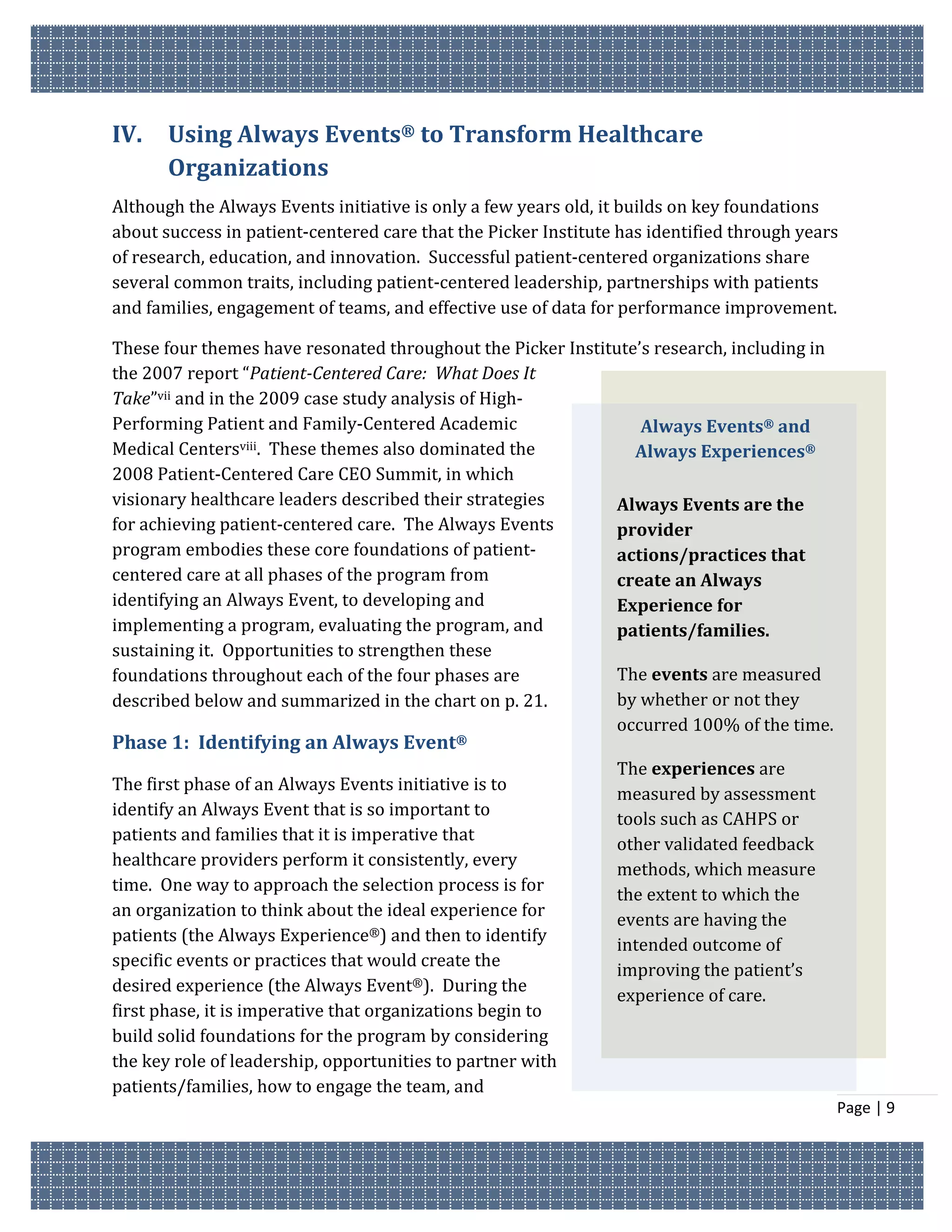
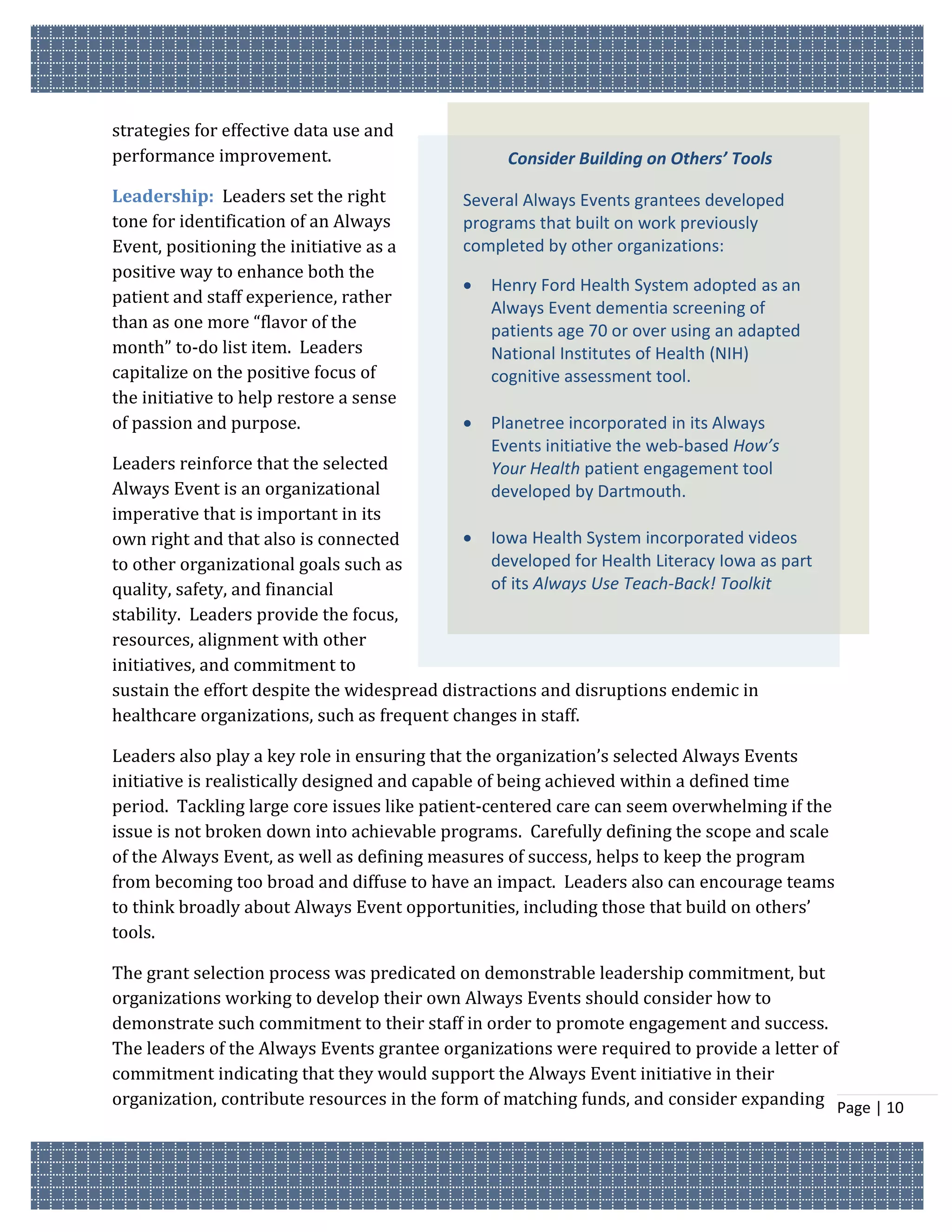
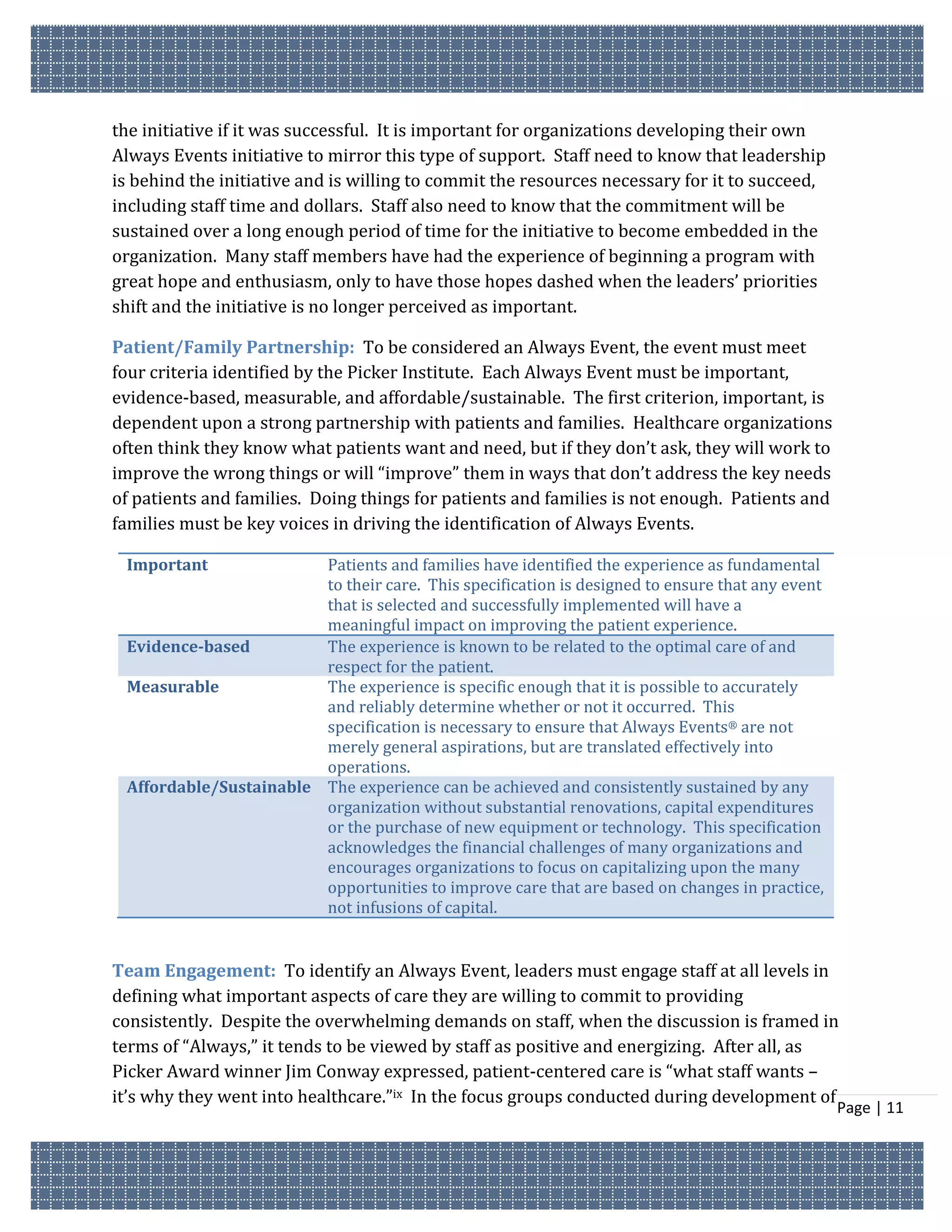
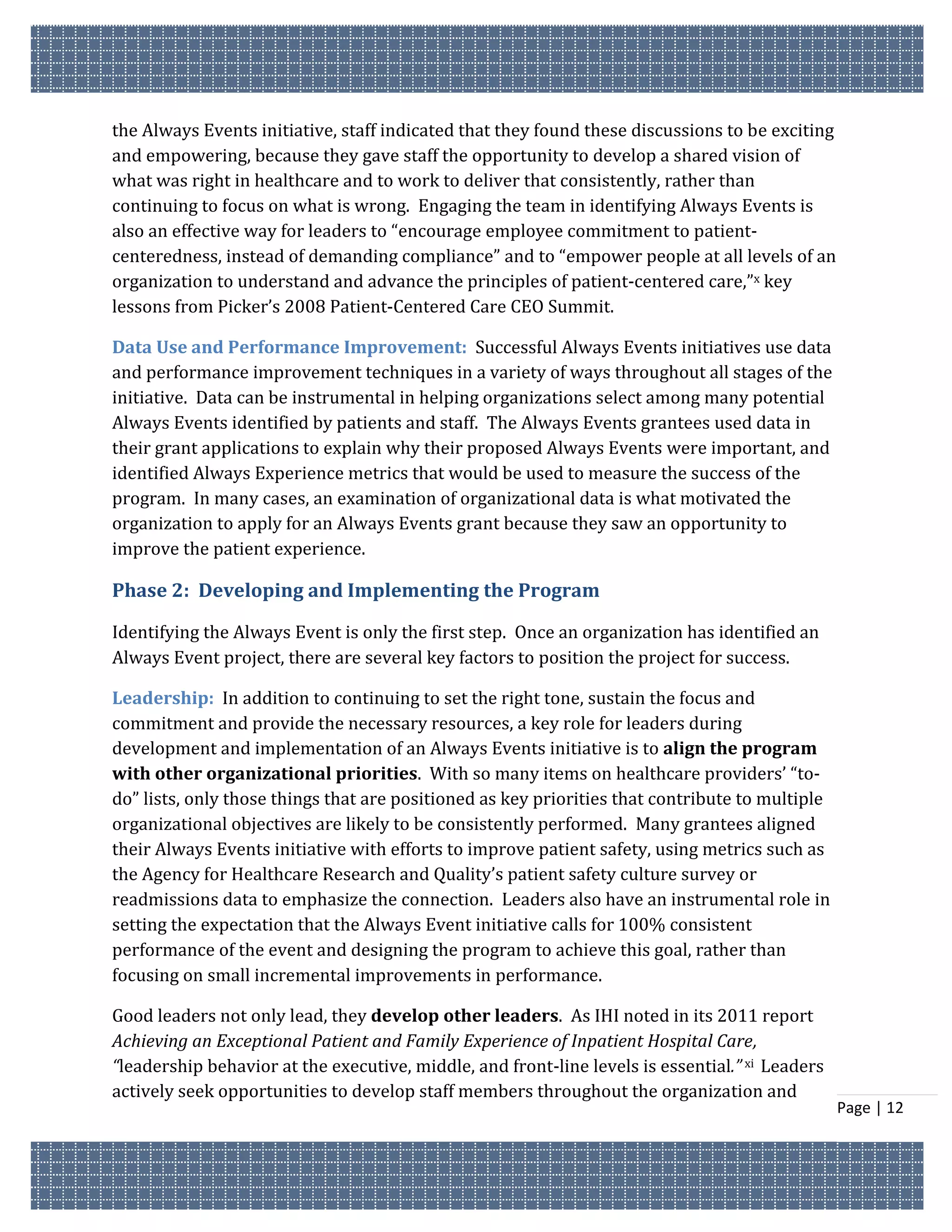
![build skills that not only will contribute to the success of the Always Events program, but to
the success of the organization. Yale-New Haven Hospital, for example, identified two staff
nurses as the project leaders for its Always Events initiative. As the principal investigator
Janet Parkosewich, DNSc, RN, CCRN, FAHA, noted, “For families to receive the level of care
we want, we have to give staff nurses these skills and experiences. . . . The project has helped
[the two nurses] to flourish as leaders. They are doing something they are passionate about
and are being given dedicated time in the schedule to do it. The Magnet program requires the
involvement of frontline staff in improvement work and this project demonstrates the
powerful impact that frontline nurses can have.”
For an Always Events project to be successful, leaders must model appropriate
behaviors. If the leaders in the organization are not behaving in a manner that is
consistent with the Always Event being implemented, staff will not engage in the project.
One Always Event initiative ran into challenges when the organizational leader questioned
the value of the project; not surprisingly, progress was slow without leadership support.
Leaders also help to put the right structure in place to support the project by building the
team as described in the team engagement section below.
Patient/Family Partnership: It is imperative that healthcare organizations directly
engage patients and families as active partners in all phases of the development and
implementation of an Always Event. This partnership can take many forms. Grantee
organizations with existing Patient and Family Advisory Councils and/or advisors
integrated into hospital operations involved those advisors in designing, implementing and
refining their programs. Organizations also sought patient and family involvement through
other formal and informal mechanisms such as focus groups, surveys, and interviews.
Incorporating patients and family members into planning is important, but the need for
involvement does not end there. Partnering with patients and family during
implementation of an Always Event is absolutely essential. Patients and families often have
very different interpretations of providers’ behavior than may be intended. For example,
one Always Events grantee who provided patients and family members with a paper tool to
record important information related to their discharge discovered that some patients
perceived the document as evidence of a lack of coordination rather than an initiative to
improve coordination of care, noting “Why do you need us to write things down – don’t you
know what we’re supposed to do?”. Patients and family members also identify opportunities
to improve communication and provide a realistic perspective on the way the event is
being implemented. One grantee discovered that patients did not understand the term
“handoffs,” and changed the language in patient materials to “change-of-shift bedside
report.” Another grantee found that although patients understood the language on the
questionnaire they were being provided while waiting for their outpatient visits, they were
not receiving any explanation from staff as to the purpose of the document. Page | 13](https://image.slidesharecdn.com/alwayseventsblueprintforaction11-2012-121212060708-phpapp02/75/Always-Events-Blueprint-for-Action-14-2048.jpg)
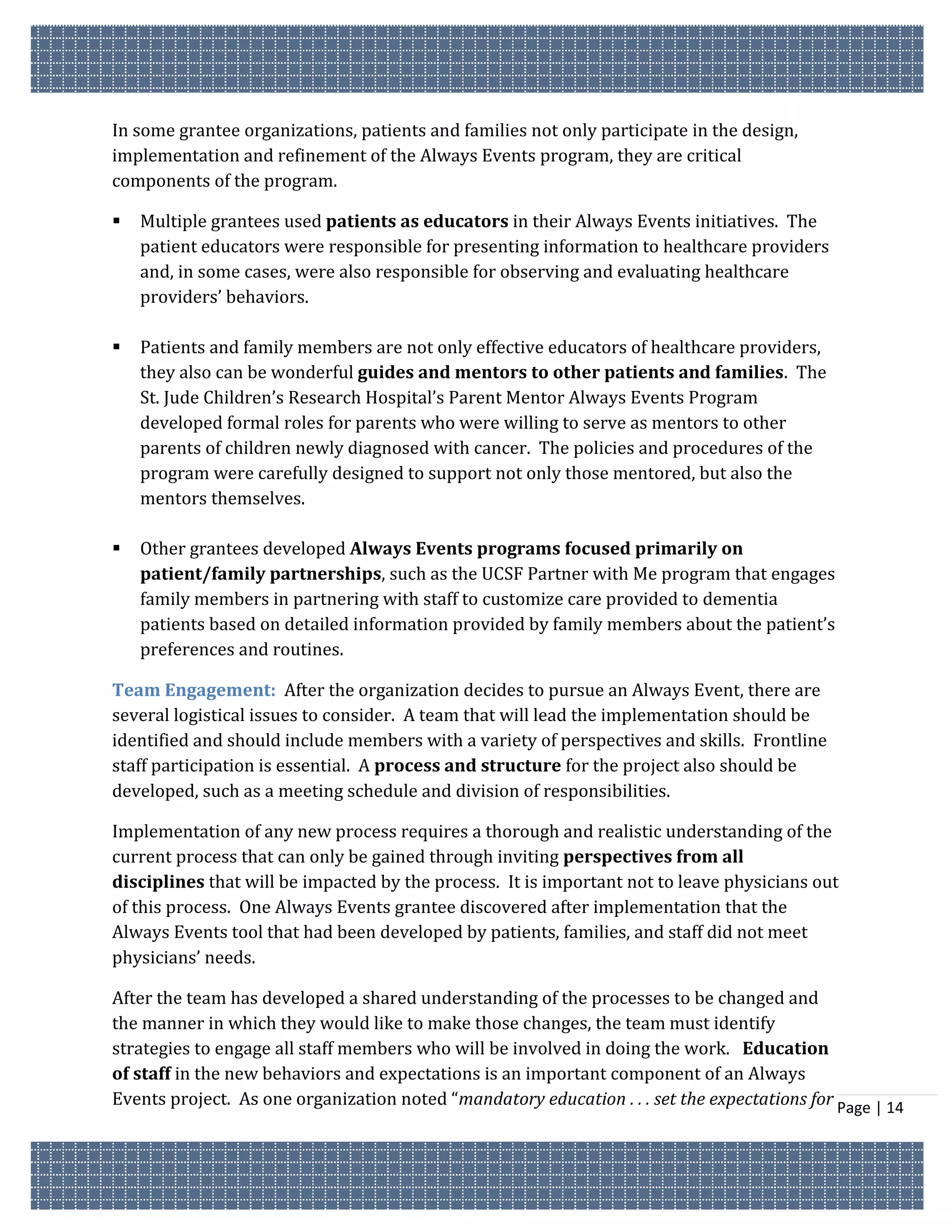
![the [A]lways [E]vent and provided the necessary knowledge, skills and attitude to fulfill the
expectations.” Always Events grantees used many types of education including online
learning, videos, simulation and role-playing, self-learning packets, and presentations.
Effective Always Events programs translate ideals into concrete behaviors for which
staff can be held accountable. Dartmouth-Hitchcock Medical Center for example, used the
acronym ALWAYS to break down patient-centered communication skills into six
observable behaviors. (A – Address and refer to patients by the name they choose, not
their disease; L – Let patients and families know who you are and your role in the patient’s
care; W – Welcome and respect those defined by the patient as ‘family’; A – Advocate for
patient and family involvement in decision making to the extent they choose; Y – Your
name badge: ensure patients can read it; S – Show patients and families the same respect
you would expect from them.)
In addition to describing “how” and “when” an Always Event will be implemented, it is
important to emphasize “why.” Patient stories can powerfully illustrate the why and
reconnect providers to their sense of mission of purpose. One grantee working on end-of-
life issues for neonates rallied staff around a powerful quote from a father, “Do clinicians
realize that we will never forget their names, their faces, and what they said to us about our
dying child?”
Education is a start, but it may not be enough to change staff behavior. Several Always
Events grantees identified “champions” or coaches who inspired and educated their
colleagues, led by example, and provided “peer-to-peer at the elbow support” and coaching
during implementation. Champions also must be supported in their roles. Some
organizations created formal written descriptions of the characteristics and
responsibilities of champions. Others convened the champions on a regular basis to
discuss how the Always Event was being implemented and to refine the program as
necessary.
Data Use/Performance Improvement: Prior to implementing a specified Always Event,
the organization should determine what metrics will be used to evaluate the program.
There may be baseline data available to compare performance before and after the Always
Event is implemented, which could affect project timing. In addition, some of the grantees
implemented Always Events on selected units and compared performance to similar
“control units” in which the Always Event was not implemented. It is important to have
these discussions prior to implementation so that the full range of evaluation options can
be discussed and appropriate tools developed before action is taken that forecloses certain
evaluation possibilities. Some of the grantees discovered mid-way through their projects
that the evaluation tools they had planned to use were not available, which limited their
ability to fully assess the impact of the Always Event. Page | 15](https://image.slidesharecdn.com/alwayseventsblueprintforaction11-2012-121212060708-phpapp02/75/Always-Events-Blueprint-for-Action-16-2048.jpg)
